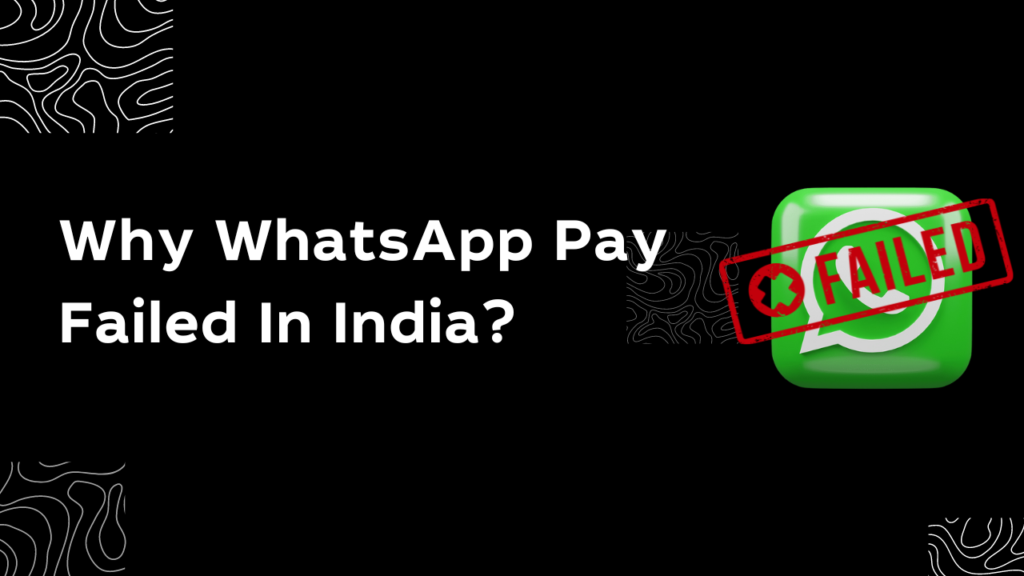India is at the heart of all that cut and thrust in digital payments. Its digital payments landscape has been growing at a breakneck pace, drawing in major players from abroad and each competing for its piece of the rapidly expanding pie. One of the services was WhatsApp Pay, a feature within the messaging app that could potentially enable quick and convenient transactions. But despite having the deep-pocketed Facebook behind it, WhatsApp Pay hasn’t taken off in any big way in India. Let’s look at the reasons why WhatsApp Pay failed in its approach towards targeting India, including a detailed analysis of everything that went wrong. We begin by discussing an overview of the Indian Digital Payments Landscape.
The digital payment space in India is complicated and fragmented. That being again a country with over 1.4 billion people and more than 500 million active internet users by early 2024, the numbers can change drastically in just one year. The market has jurisdiction over several players such as
Unified Payments Interface (UPI): UPI is a payments framework that was introduced in 2016 to revolutionise digital transactions, and it carries out more than 433 million transactions per month as of March 2024.
Google Pay: Google Pay also makes use of UPI, and has a much higher user base at up to 250 million installs.
PhonePe: With a market share of about 40% in the UPI space, PhonePe is another biggie.
Paytm: Paytm is known for its diverse services and also has a presence in digital payments with a big user base.
Launched in the year 2018, WhatsApp Pay was supposed to capitalise on the massive user base of WhatsApp which has around over 600 million users in India. The integration was for only a digital and fast payment platform said to be making payments as easy as sending SMS. It was in a perfect position to have this disruptive impact, riding on the high distribution WhatsApp had.
WhatsApp Pay — What do they struggle with?
1. Regulatory Hurdles
Navigating the complex web of regulatory hurdles in India was one of the biggest challenges for WhatsApp Pay. Data localization and compliance: the body that regulates all UPI transactions, i.e. NPCI has strict guidelines regarding data localization as well. Approval for WhatsApp was held up due to worries about data security and privacy. The launch of its UPI payment service also took a hit as WhatsApp paused the pilot in 2020 for several months.
2. Late Entry and Market Saturation
When WhatsApp Pay hit the market, UPI-based payment solutions were in place for quite some time. GooglePay and PhonePe had captured substantial market share backed by solid marketing campaigns, and user incentives. Its delayed launch placed WhatsApp Pay on the back foot as competitors had already gained a foothold in the marketplace.
3. User Experience and Trust
WhatsApp Pay, for all the usability that it promised to bring, faltered in terms of both user confidence and adoption. The users have adopted existing payment apps and don’t like the idea of switching between them. There were also fears that the app would not be secure for financial transactions. Even though it made the payment integration very smooth for WhatsApp users, many questioned data privacy and security.
4. No Unique Value Proposition
WhatsApp Pay did not actually provide a unique value proposition beyond your app of convenience. The limited nature of what WhatsApp Pay brought to the table was a large part of why it was slapped with an antitrust complaint among other things, when others who provided extra services or sweeteners around UPI did not get into similar problems. This distinction is what made it difficult to convince users to switch over to the new service.
5. Technical and Operational Issues.
Firstly, there were some technical glitches when WhatsApp Pay was first rolled out and it also faced operational issues. Transaction failures and delays, leading to erosion in trust in the service were reported by users. This lack of support as well as technical limitations further prevented users from utilizing them.
Analyzing the Numbers
To give you an idea of the significance, here are a few key statistics:
Number of Transactions: According to data from March 2024, WhatsApp Pay was doing only about a crore a month while PhonePe touched 20 crores and GooglePay dabbled with around half as many.
Market Share: WhatsApp Pay has less than 5% market share on UPI, whereas PhonePe commands ~ 40% and GooglePay ~ 30%.
Severe User Adoption: For all WhatsApp availability in India, it’s estimated that only 50 million users use it actively for transactions compared to an active user of ~ 250 million on Google Pay
When a perfect storm hit the product in India It was plagued by regulatory challenges, and it entered a crowded market with no discernible benefit that distinguished it from its increasingly plentiful competition. A lack of trust in users, as well as technical issues added to its woes. All of these factors led to WhatsApp Pay failing in its biggest strength, its large user base.
These struggles of WhatsApp Pay drive home the importance for players to understand and tailor their product offering according to local markets, especially in a rapidly expanding sector such as digital payments that treats India more like a continent than a country due to its diversity. Mapping these challenges, along with the reasons why WhatsApp Pay failed to launch helps in understanding how digital payments themselves pitch up-base on their own and what works for them or doesn’t.

